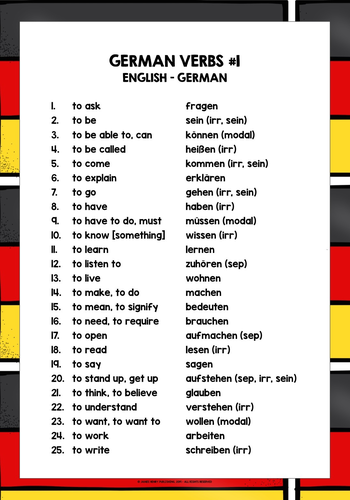





DAZ DAF BEGINNER GERMAN VERBS INTERMEDIATE GERMAN VERBS
This resource consists of two non-editable files in a zipped format, and is free to download, but please read the Terms of Use carefully, as it is copyright, all rights reserved. It may not be copied, rewritten, amended, shared or distributed outside your own classroom in any way. The license is a single-user license only. Please read the Terms of Use.
I give my students of all grades and learning phases a whole series of reference lists, that build up into a really comprehensive reference bank over the course of their German program. They’re really popular with my students, as they know they can just go to their reference file or folder, and find what they need. They tell me that they feel far more confident about their German when they have a good grasp of core vocab. They’re great for quick vocab quizzes too.
There are two alphabetical lists - one German-English, and one English-German, as I’ve found that beginner German students prefer to have both as a reference resource. I’ve noted where a verb is separable, irregular or conjugated with sein. If my group is small, I provide students with a set of double-sided and laminated reference resources. My students all have a reference file or folder, again from the beginning of their learning, and part of helping them develop independence in, and responsibility for, their learning, is to give them opportunity to keep their learning resources in good order, and easily accessible.
The verbs are all in the infinitive form - it’s an important step in learning is to ensure that students quickly develop a useful vocabulary bank, are able to recognize high-frequency German verbs, and are confident with the meaning of those verbs in English - at that point we can move swiftly on to looking at conjugation and using the verbs in a communicative and practical context. We also use our reference lists to help students audit their developing German verb vocabulary.
The list is a great time-saver for teachers too - if you’re preparing resources focusing on high-frequency German verbs for your students, the list is a good starting point.
There are two backgrounds to choose from - German flag, which I generally use for German grammar or German vocabulary display, and plain.
Have a browse in my store for more German vocabulary lists, and a wide range of other German teaching and learning resources, with German dollar deals, special offer bundles, and lots of freebies.
VIELEN DANK UND VIEL SPAß IN DER DEUTSCHSTUNDE!
Something went wrong, please try again later.
Thanks for sharing this very useful verb list
Thanks for sharing your vocabulary lists for free. I use them to create multilingual displays so that we can compare languages, and look for cognates, which really helps my students learn high-frequency vocab.
Thanks for sharing
Danke!
This is a great revision tool and the seniors love the autonomy of it.
Report this resourceto let us know if it violates our terms and conditions.
Our customer service team will review your report and will be in touch.